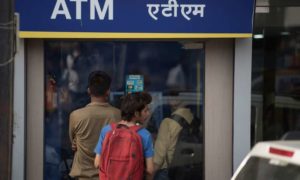Finance Minister Nirmala Sitharaman today presented the Union Budget 2020-21 in the Lok Sabha. This is the second budget after Narendra Modi led National Democratic Alliance returned to power for a second term. This year’s Union Budget centres around three ideas — Aspirational India, Economic development, A Caring Society. Central government to provide ₹99,300 crore for educational sector in FY21. New education policy will be revealed soon, said Sitharaman.
Sitharaman today also proposed new income tax slabs and lower rates. These income tax rates are optional and are available to those who are willing to forego some exemptions and some deductions.
This year’s Economy Survey projected economic growth to rebound and hit 6%-6.5% in the next financial year starting April 1.
Here are the highlights of Budget 2020
-All you need to know about new income tax slabs
In Budget 2020, Finance Minister Nirmala Sitharaman proposed a new set of income tax rates for those earning up to ₹15 lakh a year.
She proposed a 10% tax on income between ₹5 and ₹7.5 lakh from 20 per cent now.
Income between ₹7.5 lakh to ₹10 lakh will also attract a lower tax of 15%. For annual income between ₹10 lakh and ₹12.5 lakh, the income tax rate has been reduced to 20% from 30%.
Those earning ₹12.5 lakhs to ₹15 lakhs will pay 25 per cent tax. The Finance Minister said that those earning over ₹15 lakh would continue to pay the tax at the current rate of 30%. The new tax regime is optional and an individual taxpayer can opt for the structure that is beneficial for him.
–Finance Ministry sources said that there are significant numbers of people, who for various reasons, are not able to spare money from their income to invest in the various saving instruments such as Provident Fund, pension schemes, interest on house loans, insurance etc and therefore are unable to take full advantage of all deductions.
-Pensioners, job starters, entrepreneurs to gain from new income tax regime
Opting for the new tax rates proposed in the budget could be beneficial for job-starters, pensioners, entrepreneurs and those taxpayers unable to claim available deductions and exemptions under the current tax structure, government sources said.
-On income tax
The cut in income tax rates, which would help save ₹1,820 to ₹20,300 a year in tax for persons with annual income of above ₹10 lakh, was however conditioned on foregoing current exemptions and deductions, including standard deduction for ₹50,000 as well as the waiver earned on payment of up to ₹1.5 lakh in tuition fee of children, and contribution towards insurance premium and provident fund.
–Finance Minister Nirmala Sitharaman on Saturday introduced new income tax slabs for individuals, abolished dividend tax for companies and announced record spending in agriculture and infrastructure sectors
Manufacturing
-Scheme focused on encouraging manufacture of mobile phones, electronic equipment and semiconductor packaging to be introduced
-To encourage private sector to build Data Centre Parks throughout the country
-Subsidy
-Food subsidy seen at ₹1.15 trillion ($16.18 billion) in 2020/21
-Petroleum subsidy seen at ₹409.15 billion ($5.76 billion) in 2020/21
-Fertiliser subsidy ₹713.09 billion ($10.03 billion) in 2020/21
-For Power sector
-India to provide ₹273 billion ($3.84 billion) for promotion of industry and commerce
-Firms operating old thermal power plants advised to shut units if emission norms not met
-India to allocate ₹44 billion ($619.11 million) for clean air incentives in cities with over 1 million people
-Manufacturing
-Scheme focused on encouraging manufacture of mobile phones, electronic equipment and semiconductor packaging to be introduced
-To encourage private sector to build Data Centre Parks throughout the country
– ₹80 billion ($1.13 billion) over five years to be provided for quantum technologies and applications
-Milk processing capacity to be doubled by 2025
-More airports, highways
-India to develop 100 more airports by 2024
-India to monetize over 6,000 km of highways in 12 lots by 2024
-India to privatize at least one major port
-Things that will become dearer
-Customs duty on walnuts raised to 100% from 30%
-Customs duty on autos and auto parts raised by up to 10%
-Customs duty on platinum and palladium cut to 7.5% from 12.5% for certain purposes
-Nominal health cess of 5% on import of medical devices
-SUBSIDY
* Food subsidy seen at ₹1.15 trillion in 2020/21
* Petroleum subsidy seen at ₹409.15 billion in 2020/21
* Fertiliser subsidy ₹713.09 billion in 2020/21
-GROWTH/DEFICIT
- Nominal GDP growth in 2020/21 estimated at 10%
- Fiscal deficit for 2019/20 seen at 3.8% of GDP
- Fiscal deficit for 2020/21 seen at 3.5% of GDP
- Fiscal deficit for 2021/22 seen at 3.3% of GDP
- Fiscal deficit for 2022/23 seen at 3.1% of GDP
- Revenue deficit seen 2.7% of GDP in FY21
-Sub-urban rail will boost multi-modal connectivity and open up new economic opportunities for areas in and around cities like Bengaluru, said Ola Mobility Institute
–Moody’s Investors Service said the budget highlights the challenges to fiscal consolidation. India’s government debt is already “significantly higher” than the average for its Baa-rated peers, said Gene Fang, associate managing director of sovereign risk.
–Custom duty on fan upped to 20% vs 10%. Custom duty on specified goods used in refrigerators & ac hiked to 12.5% vs 10%.
-The announcement of a forthcoming policy to allow the private sector to build data center parks could potentially benefit all IT firms, including TCS, Infosys, Wipro, HCL Technologies, Tech Mahindra, along with mid-sized firms like LTI, Mindtree, Persistent, and Hexaware. Adani Enterprises also stands to benefit from this development.
-Infra sector: ₹100 lakh crore to be invested on infrastructure over the next 5 years
National Infrastructure Pipeline:
-Rs. 103 lakh crore worth projects; launched on 31st December 2019
-More than 6500 projects across sectors, to be classified as per their size and stage of development
-A National Logistics Policy to be released soon:
-To clarify roles of the Union Government, State Governments and key regulators.
-A single window e-logistics market to be created
-Focus to be on generation of employment, skills and making MSMEs competitive
-National Skill Development Agency to give special thrust to infrastructure-focused skill development opportunities
-Project preparation facility for infrastructure projects proposed
-To actively involve young engineers, management graduates and economists from Universities
-Infrastructure agencies of the government to involve youth-power in start-ups
– ₹1.7 lakh crore proposed for transport infrastructure in 2020-21
–Markets: A dividend distribution tax for companies will be scrapped, entailing a revenue loss of ₹250 billion
–Excise duties: Tax on cigarettes and other tobacco products to be increased
–FM Nirmala Sitharaman today in Budget 2020 proposed new income tax slabs and lower rates. These income tax rates are optional and are available to those who are willing to forego some exemptions and some deductions.
–The government raised fiscal deficit target to 3.8% of the GDP from 3.3% pegged earlier for 2019-20 due to revenue shortage.
Here are the key highlights of Union Budget 2020-21
-Balanced budget, said Kamlesh Rao, MD & CEO, Aditya Birla Sun Life Insurance
The Finance Minister has announced a balanced budget inspite of existing challenges in hand. It has focused on generation of employment and inclusive growth through increased expenditure on rural economy, infrastructure, MSME and healthcare. Abolition of DDT, tax relief to middle class and lower middle class segments along with simplification of the tax regime will improve public sentiment and augur well for the economy, said Kamlesh Rao, MD & CEO, amAditya Birla Sun Life Insurance
Union Finance Minister Nirmala Sitharaman announced that the Centre this year has allocated ₹9,000 crore for the welfare of senior citizens.
Also, the government has allocated ₹53,700 crore for the uplift of Scheduled Tribes, and ₹85,000 crore for the welfare of Scheduled castes and Other Backward Classes.
-TB harega desh jeetga, Sitharaman said
Finance Minister Nirmala Sitharaman on Saturday said the government is committed to eliminating tuberculosis by 2025.
“The government will launch “TB harega desh jeetga” (TB will be defeated and the country will win) campaign to eliminate tuberculosis by 2025,” said Sitharaman while presenting the budget.
-Ayushman Bharat
Union Budget 2020 allocated ₹69,000 crore for healthcare sector. Out of the total amount, ₹6,400 crore will be sanctioned for Ayushman Bharat Yojna.
Ayushman Bharat scheme provides health assurance cover of up to ₹5 lakh per family and is targeted to cover over 10 crore poor and vulnerable families.
Here’s a list of key budgetary allocations
FY21 agriculture allocation ₹1.38 lakh crore
FY21 rural development allocation ₹1.23 lakh crore
FY21 agriculture and rural allocation ₹2.83 lakh crore
FY21 agriculture credit target ₹15 lakh crore
FY21 education allocation at ₹99,300 crore
FY21 healthcare allocation at ₹69,000 crore
FY21 transport infra allocation at ₹1.7 lakh crore
-Budget 2020 removed 70 exemption from personal income tax
-For MSME sector
Audit threshold for MSMEs raised to ₹5 crore from ₹1 crore
-More on tax front
-100% tax exemption on Soverign Wealth Funds’ Indra Investment.
-Concessional 5% withholding tax entended to municipal bonds, Nirmala Sitharaman
-FM Nirmala Sitharaman on the new tax regimes: Lowest, simplest, smoothest
-On DDT
Dividend Distribution Tax to be removed, companies will not be required to pay DDT, dividend to be taxed only at the hands of recipients at applicable rates
-Huge relief for individuals
Here is the new income tax slabs
0 – 2.5 lakh – exempted
₹2.5 lakh – ₹5 lakh – 5%
₹5 lakh – ₹7.5 lakh – 10% (20% earlier)
₹7.5 lakh – ₹10 lakh – 15% (20% earlier)
₹10 lakh to ₹12.5 lakh – 20% (30% earlier)
₹12.5 lakh – ₹15 lakh – 25% (30% earlier)
No change in tax rates above ₹15 lakh
– Personal income tax is at lowest rate of all time, Nirmala Sitharaman
-Income tax rates will be significantly reduced for those who forego reliefs, exemptions, said FM Sitharaman
-Personal tax simplified
-For income between ₹12.5 lakh to 15 lakh, the income tax rate will be 25%
-For income more than 15%, it will attract an income tax will be charged at 30%
-Personal tax rates reduced
-Individuals have to pay 10% income tax for income between ₹5- ₹7.5 lakh
-For income tax between ₹7.5 lakh- ₹10 lakh, he or will she will have pay 15%
-Those earning ₹10 lakh- ₹12.5 lakh, will be charged 20% income tax
-Central government on Saturday proposed an outlay of ₹27,300 crore for the development of industry and commerce during 2020-21
–Power to power sector
-India to provide ₹273 billion or promotion of industry and commerce
-Firms operating old thermal power plants advised to shut units if emission norms not met
-India to allocate ₹44 billion for clean air incentives in cities with over 1 million people
-FY21 divestment target pegged at ₹2.1 lakh crore
-Skill India initiative
Government proposed ₹3,000 crore for ‘Skill India’ to provide relevant skill training to the youth in the country, said Finance Minister Nirmala Sitharaman on Saturday.
“There is a huge demand for teachers, paramedical staff and caregivers in foreign countries. However, their skills do not match in accordance to demand by employers. So, my government proposes ₹3,000 crore for skill development,” she said during the 90th Budget presentation.
-Government to sell govt stake in IDBI Bank to private investors
-Government plans to sell stake in LIC through IPO, said Nirmala Sitharaman
-FY21 fiscal deficit target pegged at 3.5% of GDP
-Connecting India
-Finance Minister Nirmala Sitharaman said ₹6,000 crore allocated for BharatNet programme
– Around 1 lakh gram panchayats to be linked with BharatNet this year
-To clean air and pollution free cities
- Power plants with emissions above prescribed limits will be asked to close down.
- India’s commitment towards tackling climate change made at Paris conference kick starts from January 1, 2021.
- FM said ₹4,400 crore has been allocated for states that work towards clean air.
-Your money becomes safer
–Deposit insurance coverage increased to ₹5 lakh from the existing ₹1 lakh.
-Swachh Bharat Mission
- The Finance Minister announced that the total allocation proposed for Swachh Bharat Mission is ₹12,300 crore
- Nirmala Sitharaman said the NDA government is “committed to Open Defecation Free (ODF) plus in order to sustain ODF behavior and to ensure no one is left behind.”
-For health sector:
- Union Budget 2020 provided an additional ₹69,000 crore for the health sector
- Finance Minister proposed to attach a medical college to a district hospital in PPP model
-Say ‘no’ to pollution:
Govt will encourage states which formulate plans for air pollution scheme soon. ₹4,400 crore allocated for 2020-21: Sitharaman
– ₹8,000 crore allocated over 5 years for National Mission On Quantum Technology, said Finance Minister Nirmala Sitharaman
–For Indian Railways
– 4 station re-development projects in railways via PPP models
-To develop solar capacity in Indian railways
-Plan more Tejas like trains to connect tourist locations
-Govt to launch ₹18,600 crore worth Bengaluru Suburban Transportation project
-Push for renewable energy sector
FM announced ₹20,000 crore for the renewable energy sector
-Central government is planning to construct
-2500 access control highway
-9000 km eco-development corridors
-200 coastal and port roads
-2000 km strategic highways
-Delhi-Mumbai expressway and 2 other corridors will be completed by 2023
– ₹1.7 lakh crore for transport infrastructure
Finance Minister Nirmala Sitharaman proposes to provide ₹1.7 lakh crore for transport infrastructure in 2020-21
-Transport sector
- Cente to provide 20% equity for Bengaluru Suburban Transportation Raj
- 100 more airports to be developed by 2024 to support Central government’s “Udaan” scheme
-For agricultural sector:
– Govt has pegged the agricultural credit target at ₹15 lakh crore for fiscal 2020-21.
– Indian Railways will set up Kisan Rail in public–private partnership (PPP) mode for cold supply chain to transport perishable goods.
– Nabard refinance scheme will be expanded
-For education sector:
150 higher education institutions to offer apprenticeship diplomas by March 2021. Government will promote ‘Study In India’ initiative.
-New education policy to be announced soon
Govt to provide ₹99,300 crore for educational sector in FY21
-FM Nirmala Sitharaman said, “By 2030, India will have largest working age population in the world. This population needs both job and life skills. New education policy to be announced soon.”
-Government proposes to attach a medical college in existing district hospitals, said FM
-Finance Minister announced these schemes for agri sector
- Civil Aviation Ministry to launch ‘Krishi Udaan’ for agricultural exports
- Krishi Udaan will be launched by Civil Aviation Ministry to transport agri-products to national as well international destinations
-The total allocation for Swachh Bharat mission is 12,300 crores for FY20-21
-FM Nirmala Sitharaman on Agriculture:
- NBFC’s & co-operatives active in credit
- NABARD refinance scheme to be strengthened
- Agri credit target ₹15 lakh crores
- Eligible PM KISAN beneficiaries covered under KCC
-Finance Ministry will allocate ₹2.83 crore for agriculture and irrigation. ₹1.23 lakh crore will be allocated to rural development, panchayati raj
-Finance Minister Nirmala Sitharaman shared measures to be taken to help farmers
1) Government is expanding ‘PM Kusum Scheme’ to 20 lakh farmers to set up solar pumps
2) Government will set up solar power units
-Finance Minister NirmalaSitharaman encouraged the balanced use of all fertilisers including traditional & organic. Focus will be to change prevailing incentive scheme that encourages use of chemical fertilisers
-Online natural product will also be strengthened, said FM
-Committed to doubling farm income by 2022, said FM
-India is now 5th largest economy in world, said Nirmala Sitharaman
-Finanace Minister lays down 16 actionable plan to enhance farmer’s incomes. Farm markets need to be liberalised.
-Central govt’s debt has come down to 48.7% in March 2019 from 52.2% in March 2014
-This year’s Budget centres around three ideas — Aspirational India, Economic development, A Caring Society
–GST benefit of ₹1 lakh crore has been extended to consumers
–Introducing simpler GST filing system from April 2020, said Sitharaman
-16 lakh new taxpayers added to the system, revealed Sitharaman.
-An average household now saves about 4% of its monthly spend on account of reduced GST, said Sitharaman.
–In the last two years, we have added more than 60 lakh new tax payers. There has been extensive engagement with stakeholders. A simplified returns system is being introduced from April, said Finance Minister.
–Central government focussed on structural reform. GST has been most historic structural reform that India witnessed.
-Finance Minister started her Budget speech by paying homage to former Finance Minister Arun Jaitley.
-This is the budget aims to address hopes and aspirations of all the sectors, said Finance Minister
-Finance Minister presented Union Budget 2020-2021 in the Lok Sabha
-” Bahi-khata symbolises our departure from the slavery of Western thought,” said Chief Economic Advisor Krishnamurthy Subramanian during Union Budget 2019.
-For her second budget presentation, Union Finanace Minister Nirmala Sitharaman today carried documents in a ‘Bahi-Khata’ wrapped in a red cloth.
Last year, FM Sitharaman ditched the tradition of carrying budget documents in a leather briefcase.




































